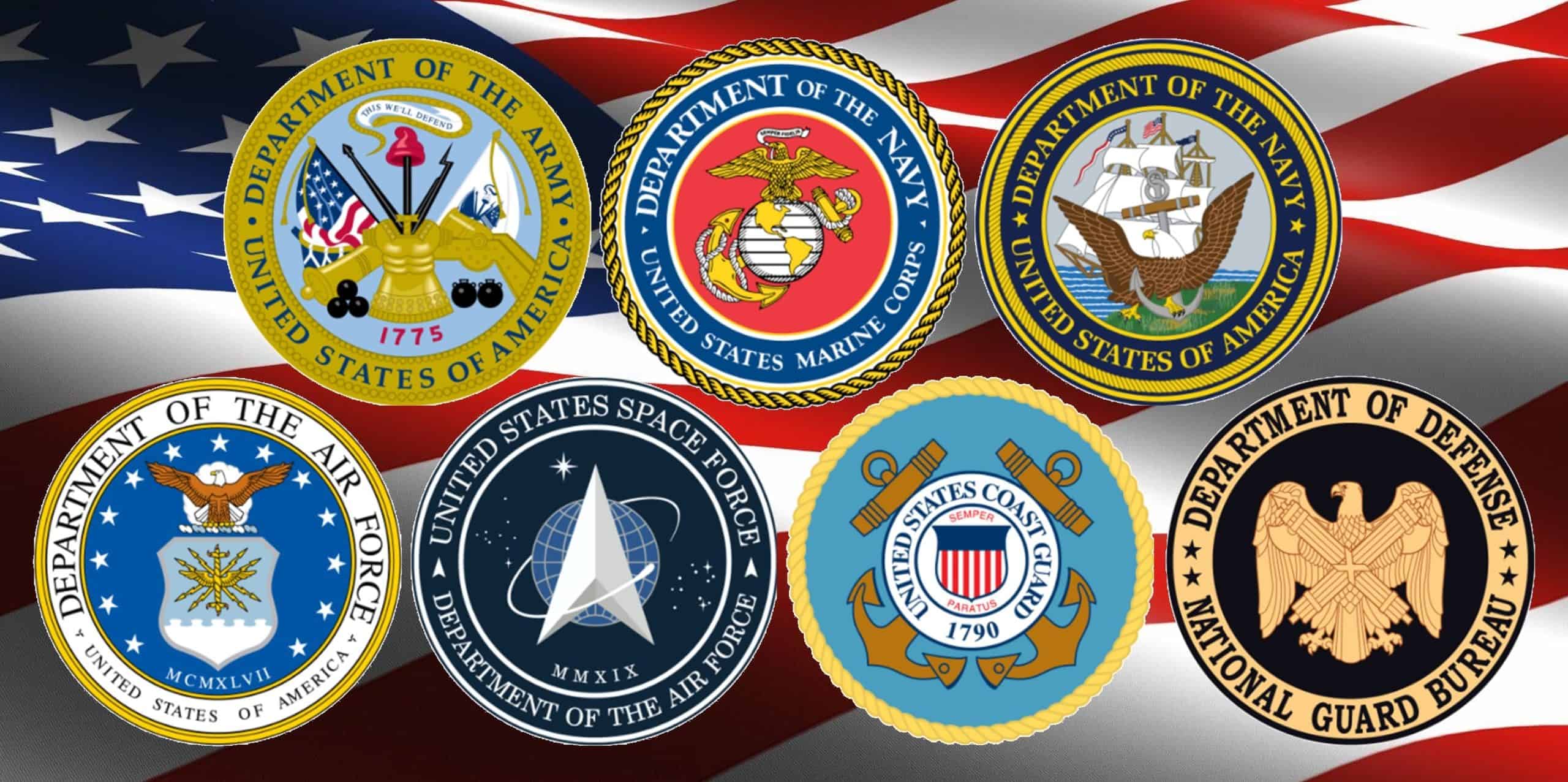The United States military, a pillar of the nation’s identity and strength, is steeped in a history that stretches back more than two centuries. Embedded in this rich chronicle are stories of resilience, heroism, and unwavering service, many of which find their roots in the military’s unique and complex rank structure.
More than a mere symbol of authority, each rank in the U.S. military signifies a unique blend of responsibility, duty, and sacrifice. From the freshly graduated Army Private to the seasoned Navy Admiral, every step up the ladder is a testament to a servicemember’s dedication, competence, and resilience. Yet, understanding the U.S. military’s rank structure is more than an exercise in comprehending a hierarchy; it’s a journey through the underlying values that define the military—honour, respect, and an unyielding commitment to protect and serve.
Across the Army, Navy, Air Force, Marines, Coast Guard, and the newly established Space Force, this structure plays a pivotal role. Each branch, while united under the broad umbrella of the U.S. military, boasts its own unique culture, traditions, and roles, all reflected in their distinct hierarchies.
We’ll embark on an exploration of these hierarchies and the heroes that fill their ranks. We’ll shine a spotlight on the structure that guides them, the roles they perform, and the indomitable spirit of service that binds them all. As we journey through the rich tapestry of the U.S. military’s past and present, we hope to foster a deeper understanding and appreciation for what these ranks represent—not just for the servicemen and servicewomen who wear them, but for the nation they serve.
Section I. Understanding The Ranks.
The U.S. military’s rank structure is like a meticulously assembled puzzle, each piece fitting snugly into its place to form a coherent whole. To truly comprehend this structure, we must start from the ground and ascend, examining each rank’s responsibilities and requirements along the way.
Imagine a fresh recruit, eager and ready to serve their country. This individual begins their journey as an ‘Enlisted’ service member, the backbone of the U.S. military. Depending on the branch they’ve chosen, they could be a Private in the Army or Marine Corps, an Airman in the Air Force, a Seaman Recruit in the Navy, or a Coast Guard recruit. These are the individuals who carry out the bulk of the military’s operational work—whether it’s the maintenance of military equipment, execution of tactical operations, or simply standing guard.
With time, experience, and demonstrated leadership potential, our recruit may ascend to the ‘Non-Commissioned Officer’ (NCO) ranks, becoming a Corporal or a Sergeant in the Army or Marines, or a Petty Officer in the Navy, Coast Guard, or a non-commissioned officer like a Staff Sergeant in the Air Force. These individuals are the key link between the enlisted personnel and the higher ranks, responsible for the direct supervision of enlisted personnel and execution of missions. Picture a Sergeant leading a team on a rescue mission in a hostile territory or a Petty Officer conducting damage control on a naval vessel.
Further up, we reach the ‘Commissioned Officer’ ranks. These include titles such as Lieutenant, Captain, Major, and various grades of General or Admiral. These ranks require higher education (typically a bachelor’s degree or higher) and completion of officer training. The responsibilities here are greater, encompassing command of larger units, strategic planning, and high-level decision-making. Imagine a Lieutenant Colonel devising a strategy for a major operation or a Navy Captain commanding an aircraft carrier.
At the very top sit the ‘Flag Officers’ – Generals and Admirals. These are the top military strategists and advisors, responsible for high-level command and providing military advice to national leadership. They carry the burden of thousands of lives and the security of the nation on their shoulders.
Remember, these are broad strokes, and within each category, there are multiple levels and variations. Not to mention, the Space Force, the newest branch of the military, is still defining its unique rank structure.
Each rank comes with its own responsibilities and challenges, and the path from an eager recruit to a top commander is long and demanding. However, it is this very journey that moulds ordinary citizens into the dedicated servicemen and servicewomen of the U.S. military, united by a common thread of service, honour, and commitment.
Section II. Branch Breakdown.
A deeper dive into the U.S. military reveals a distinct mosaic of branches, each with its own rich history, unique role, and vibrant culture. Let’s embark on a journey across the Army, Navy, Air Force, Marines, Coast Guard, and the fledgling Space Force.

U.S. Army.
Established in 1775, the U.S. Army is the oldest branch of the military. It serves as the primary land-based portion of the military, with the role of protecting the security of the United States and its resources. Each Soldier, as Army personnel are known, embodies a culture of readiness, resilience, and unwavering loyalty to the country. Picture a seasoned Army Ranger, Sergeant Major Jones, recounting tales of overseas deployments and how the Army’s camaraderie carried him through.
U.S. Navy.
With its inception dating back to 1775, the U.S. Navy is charged with the daunting task of maintaining freedom of the seas, deterring aggression, and achieving victory at war. Navy Sailors, steeped in a culture of honour, courage, and commitment, traverse the globe, serving aboard ships, submarines, and aircraft. Listen to Chief Petty Officer Smith, a submariner, as he narrates the breathtaking experience of silently gliding through the depths of the ocean.
U.S. Air Force.
The youngest of the original military branches, the Air Force, separated from the Army in 1947, serves as the nation’s aerial and space warfare branch. Air Force Airmen hold a culture of “integrity first, service before self, and excellence in all we do.” Imagine Major Johnson, a fighter pilot, speaking about the thrill and precision of piloting a supersonic aircraft in the face of adversity.
U.S. Marine Corps.
Founded in 1775 as a maritime infantry force, the Marines operate closely with the U.S. Navy. Renowned for their tenacity, Marines embrace a warrior culture and are often the first on the ground in combat situations. Hear Corporal Davis, a Marine Infantryman, share his pride in being part of the military’s rapid reaction force.
U.S. Coast Guard.
Established in 1790, the Coast Guard serves as the maritime security, search and rescue, and law enforcement service. Coast Guardsmen embody a culture of devotion to duty, honour, and respect. Follow Petty Officer Williams, a Coast Guard rescue swimmer, as she recounts a daring high-seas rescue mission in stormy weather.
U.S. Space Force.
As the newest military branch, established in 2019, the Space Force is tasked with space warfare operations. The Guardians, as they are known, are charting a new culture defined by innovation, agility, and a pioneering spirit. Envision Captain Lee, one of the first Space Force Guardians, describing the uncharted territory of ensuring the U.S.’ space superiority.
Each military branch, with its own customs, traditions, and ethos, contributes to the formidable strength of the U.S. military. Yet, they all share a common bond — a commitment to protect and serve the United States.
Section III. Ranks In Action.
The importance of rank structure is truly brought to life in the theatre of operations. It’s here that the responsibilities and command associated with each rank translate into action, informing decision-making and strategy. Let’s examine key moments in U.S. military history where rank, command, and structure were pivotal.
Battle of Gettysburg.
One of the most significant battles during the American Civil War, the Battle of Gettysburg, demonstrates the importance of the chain of command in a large-scale conflict. Union General George G. Meade’s decision to make a defensive stand against the Confederate Army led by General Robert E. Lee was critical in turning the tide of the war. Despite being relatively new to his rank, Meade’s bold decisions and the trust he placed in his subordinate officers showcased the effectiveness of a well-coordinated rank structure.
World War II – D-Day.
The D-Day invasion, one of the most complex military operations ever undertaken, demanded unprecedented levels of coordination and obedience to the rank structure. Supreme Allied Commander General Dwight D. Eisenhower’s crucial decision to proceed despite poor weather rested on trust in the abilities and bravery of servicemen across the rank spectrum. This trust trickled down to even the lowest ranks, with each soldier understanding their role and carrying out their duties, ultimately leading to a successful operation.

Operation Desert Storm.
In the 1991 Gulf War, General Norman Schwarzkopf, commander of the coalition forces, employed a strategy of deception and overwhelming force to liberate Kuwait. Schwarzkopf’s leadership and the structure of command played pivotal roles in executing the ‘Left Hook’ flanking manoeuvre, highlighting the importance of ranks in managing complex battle plans involving multiple nations’ military branches.
Operation Neptune Spear.
The 2011 mission to capture Osama Bin Laden, known as Operation Neptune Spear, demonstrated the importance of rank structure in the context of Special Operations. Admiral William H. McRaven, as the head of Joint Special Operations Command, trusted his experienced team, which included lower-ranking SEAL operatives. Each rank had a specific role to play in this high-stakes operation, and adherence to the chain of command contributed to the mission’s success.
These historical examples illuminate the vital role that rank structure plays in the U.S. military. From making crucial command decisions to the execution of duties on the front lines, each rank, each role has a purpose and the potential to shape the course of events. Understanding this structure allows us a glimpse into the complex workings of military operations and the critical role of each servicemember in securing the nation’s safety and freedom.
Section IV. The Human Aspect.
While understanding the rank structure provides insight into the organisational operation of the U.S. military, the human aspect of service is perhaps the most compelling. Beneath the ranks and uniforms are individuals who’ve made a commitment to uphold their nation’s ideals, often facing immense challenges and personal sacrifices along the way. To truly appreciate the U.S. military, we must comprehend this human element.

Personal Stories.
Each military servicemember has a unique journey. Consider Private First Class Martinez, who joined the Army straight out of high school, seeking to follow in his father’s footsteps. Stationed far from home, he has had to grow up fast, mastering the skills of his job while navigating the responsibilities of adulthood. Or Captain Rodriguez, a mother of two, balancing her demanding role as an Air Force pilot with her commitment to her family, showing her children the value of service and sacrifice. And there’s Sergeant Major Johnson, a Marine with three decades of service, who has experienced the thrill of victory, the agony of loss, and the relentless grind of deployments, embodying the phrase “Semper Fidelis” (always faithful) through it all.
Family Perspectives.
The families of military servicemembers also shoulder the weight of service. From saying goodbye to loved ones deployed to far-off lands, to managing households single-handedly, military families endure periods of stress, uncertainty, and worry. However, these same challenges often bring families closer together, fostering a deep sense of pride in their loved ones’ service.
Psychological And Emotional Impact.
Military service leaves an indelible mark on those who choose to serve. From the adrenaline of combat to the camaraderie developed among fellow soldiers, from the pride of promotion to the sorrow of losing comrades, the psychological and emotional landscape of a military servicemember is complex. Recognising the mental health challenges faced by many in the military is an essential aspect of acknowledging the human cost of service. Effective support networks, counselling, and mental health services are vital in addressing these issues.
Understanding the human aspect of military service brings a profound appreciation for the men and women who choose to wear the uniform. The U.S. military’s rank structure not only organises a complex system but stands as a testament to the human spirit’s resilience, dedication, and selfless service. From the newly enlisted recruit to the seasoned General, each individual in the chain of command contributes their part in this larger narrative, shaping and being shaped by their experiences. They are the lifeblood of the U.S. military, and their stories echo within the halls of its storied history.
Section V. Evolving Roles And Future Trends.
The U.S. military, mirroring society at large, is constantly evolving. The rank and role of military personnel are no exception. In this age of rapid technological advancement and changing societal norms, the future of military service is being reshaped, with significant implications for the traditional rank structure and the nature of service.
Increased Roles for Women.
Women have been part of the U.S. military in various capacities for centuries, but their roles have dramatically expanded over the last few decades. From the landmark decision in 2013 to lift the ban on women in combat roles, to the appointment of the first female four-star general in 2008, women have progressively shattered glass ceilings in the military. This gender integration has brought about a significant cultural shift within the military hierarchy and is reshaping the understanding of leadership and service.
Technological Advancements.
The rapid advancement of technology has led to the creation of new roles and ranks within the military. In the realms of cybersecurity, unmanned vehicle operation, and artificial intelligence, to name just a few, new specialisations are constantly emerging. For instance, the U.S. Air Force now includes drone operators, a position that didn’t exist a few decades ago. Additionally, with the establishment of the U.S. Space Force, we see an entirely new branch of the military developing, with its unique ranks and roles.
The Future of Warfare.
The nature of warfare is changing. Cyber warfare has become a crucial aspect of national defence, with nations recognizing the potential for major disruption through digital channels. Likewise, space is increasingly seen as the next frontier of defence strategy. These changes necessitate a rethinking of traditional rank structures and the development of specialised units and leadership roles to meet these new challenges.
Potential Impact On Rank Structure.
As new specialities emerge and evolve, the traditional rank structure of the military may need to adapt. A more flexible and dynamic approach might be required to accommodate these changes and ensure the U.S. military remains responsive and effective. However, any adaptations would need to maintain the core principles of hierarchy, discipline, and command that underpin the rank structure.
The future of the U.S. military promises a continuous evolution of roles and ranks as it adapts to new challenges and opportunities. Through these transformations, the commitment to the principles of duty, honour, and service will remain steadfast, guiding the men and women who serve as they navigate an ever-changing landscape. Their stories and sacrifices will continue to define the character of the U.S. military, even as its face changes in the years to come.
The Unwavering Commitment To Service.
The United States military, an institution steeped in history and tradition, remains a formidable force built on the tenacity, sacrifice, and courage of countless individuals. The rank structure, in all its complexity, not only outlines the chain of command but also signifies the path of personal growth and commitment to service that each servicemember undertakes.
The journey through these ranks is not without its challenges. There are times of hardship and struggle, moments of triumph and sorrow, and periods of change and uncertainty. Yet, each individual’s resilience and dedication to their sworn duty drive them forward, impacting not only their lives but also the lives of their families and the fabric of our society.
Our freedom and way of life are safeguarded by these individuals who, regardless of rank or role, are united in their commitment to service. As roles evolve and new challenges emerge, this commitment remains unwavering, providing a solid foundation for the U.S. military’s adaptation and resilience.
Looking to the future, we see a military that continues to grow and adapt, reflecting the changes in our society and harnessing technological advancements. The evolution of roles, the increased integration of women, and the development of new specialities paint a picture of a military that is dynamic and ready to face the challenges of tomorrow. Despite these changes, the values of honour, duty, and service remain steadfast, guiding the men and women of the U.S. military as they navigate the path ahead.
This path will not be without its trials, but history has shown that the U.S. military, with its disciplined structure and unwavering commitment to service, can meet these challenges head-on. It is a testament to the enduring spirit of service that defines the military.
As we recognise the sacrifices made by these individuals and their families, we should also foster a sense of hope and optimism for the future. Their stories of courage, dedication, and resilience serve as powerful reminders of what we can achieve when we stand united in service to a cause greater than ourselves.
Indeed, the future of the U.S. military is bright, filled with promise and potential. As we look ahead, let us remember the legacy of those who have served, honour the dedication of those who serve today, and support the journey of those who will serve tomorrow. For it is through their service that our freedom and way of life are preserved.












